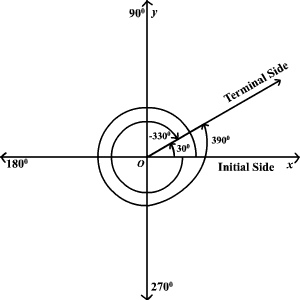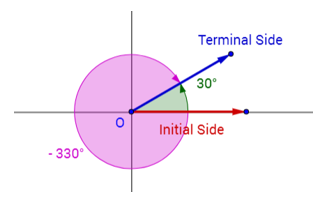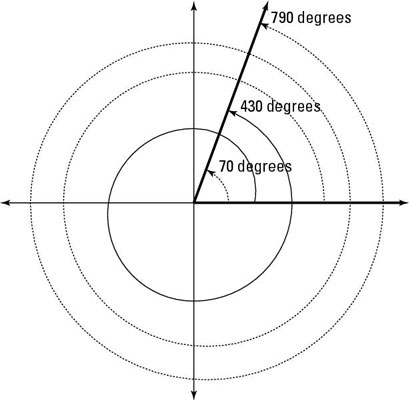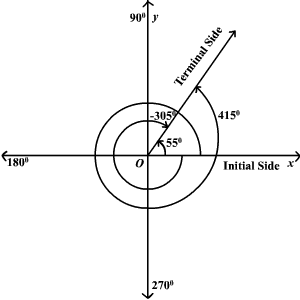
Coterminal Angles are angles who share the same initial side and terminal sides. Finding coterminal angles is as simple as adding or subtracting 360° or 2π to each angle, depending on whether the given angle is in degrees or radians. There are an infinite number of coterminal angles that can be found. Following this procedure, all coterminal angles can be found. This is the basis for solving trigonometric equations which will be done in the future.Radians are often used in trigonometry to represent angle measures. Radian measures are very common in calculus, so it is important to have an understanding of what a radian is.
Definition of a Radian
A radian is the measure of a central angle θ that intercepts an arc s equal in length to the radius r of the circle. There are 2π , or approximately 6.28318, radians in a complete circle. Thus, one radian is about 57.296 angular degrees.

In other words, if we were to take the length of the radius of a circle, and lay in on the edge of a circle, that length would be one radian.
The number π is often used when describing radian measure. The approximate value of π is 3.14159… A plane, in trigonometry, can not only be divided into quadrants using degree measures, but radian as well. Observe the following moving in a counterclockwise direction.
When studying trigonometry, angles are usually measured in radians.
In relation to degrees, 180° is π radians. This means 2π radians is 360°. Since the
approximate value of π is 3.14159…, it follows that 360° is approximately 6.28318…radians. When evaluating angles in trigonometry or calculus, always be aware of whether the question is given in terms of degrees or radians. If no degree symbol is given, the problem is in radians.
Two angles in standard position that have a common terminal side are called coterminal angles. Coterminal angles are the result of the rotation of the terminal side. They differ in multiples of 360 degrees.

An angle is said to be in standard position if it is drawn on the Cartesian plane (x-y plane) on the positive x-axis and turning counter-clockwise (anti-clockwise).
The initial side of an angle is the ray where the measurement of an angle starts.
The terminal side of an angle is the ray where the measurement of an angle ends.
Co-terminal angles are angles which when drawn at standard position share a terminal side. For example, 30°, -330°, 390° are all coterminal.

The following diagram shows the coterminal angles 30°, -330°. Scroll down the page for more examples and solutions.

We can find the coterminal angles of a given angle by using the following formula:
Coterminal angles of a given angle θ may be obtained by either adding or subtracting a multiple of 360° or 2π radians.
Coterminal of θ = θ + 360° × k if θ is given in degrees,
Coterminal of θ = θ + 2π ×k if θ is given in radians.
Two angles are coterminal if the difference between them is a multiple of 360° or 2π.
IDENTIFYING COTERMINAL ANGLES
Two angles are coterminal if they have the same terminal side. You have an infinite number of ways to give an angle measure for a particular terminal ray. Sometimes, using a negative angle rather than a positive angle is more convenient, or the answer to an application may involve more than one revolution (spinning around and around).
Angles can have terminal sides that involve one or more full revolutions around the origin or terminal sides that go clockwise instead of counterclockwise — or both of these situations can happen.
MORE THAN ONE REVOLUTION
An angle measuring 70 degrees is coterminal with an angle measuring 430 degrees. The angle measuring 430 degrees is actually 360 + 70 (one full revolution plus the original 70). These two angles are also coterminal with an angle of 790 degrees (360 + 360 + 70 = 790). This pattern could go on and on, with the addition of another 360 degrees each time.

NEGATIVE COTERMINAL ANGLES
An angle of 70 degrees is coterminal with an angle of –290 degrees. Two rotations in the negative (clockwise) direction give you an angle of –650 degrees (–290 – 360 = –650).
Finding Coterminal Angles
There are some rules in finding the coterminal angles of a particular angle based on the measurement of the angles, whether it is in radians or degrees. The rules are as follows:
Rule 1: If the given angle X is in degrees, the coterminal angle is found by adding or subtracting k * 360 to the angle X, where k is any positive or negative integer.
Rule 2: If the given angle X is in radians, the coterminal angles is found by adding or subtracting k * 2ππ to the angle X, where k is any positive or negative integer.

Examples:
1. Determine if the following pairs of angles are coterminal
a) 10°, 370°
b) –520°, 200°
c) –600°, –60°
Solution:
a) 10° – 370° = –360° = –1(360°), which is a multiple of 360°
So, 10° and 370° are coterminal
b) –520° – 200° = –720° = –2(360°), which is a multiple of 360°
So, –520 and 200° are coterminal
c) –600° – (–60°) = –540°, which is not a multiple of 360°
So, –600° and –60° are not coterminal
2. Find a positive and a negative angle coterminal with a 55°55° angle.
55°−360°=−305°
55°+360°=415°
A −305°angle and a 415° angle are coterminal with a 55° angle.

3. Find a positive and a negative angle coterminal with a π3π3 angle.
π/3+2π=7π/3
π/3−2π=−5π/3
A 7π/3 angle and a −5π/3 angle are coterminal with a π/3 angle.

For more examples watch this…
If you want to learn more watch this…
References:
https://math.tutorvista.com/geometry/coterminal-angles.html
Click to access filedownload.ashx
https://www.varsitytutors.com/hotmath/hotmath_help/topics/coterminal-angles
https://www.dummies.com/education/math/trigonometry/identify-coterminal-angles/


Leave a comment